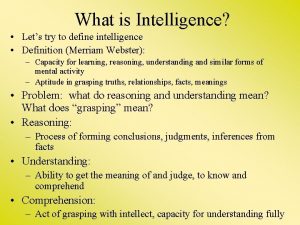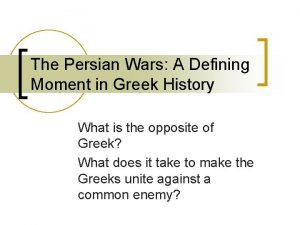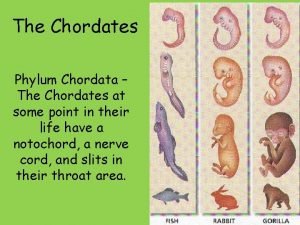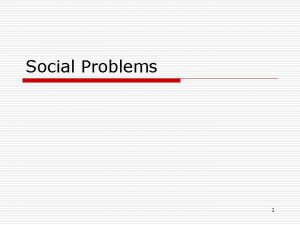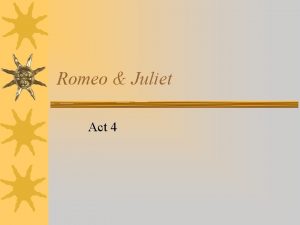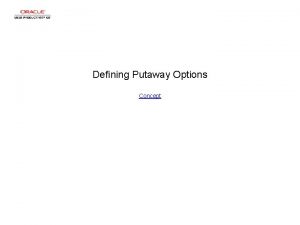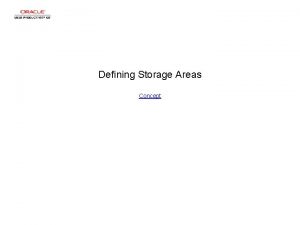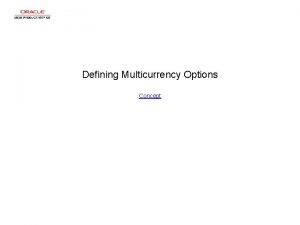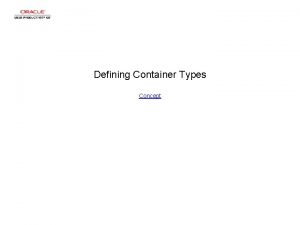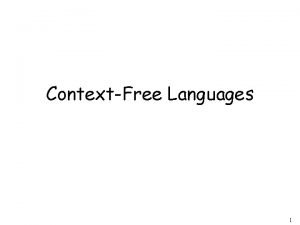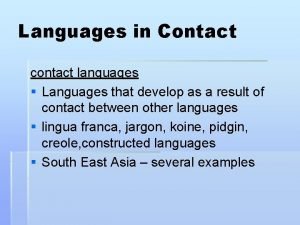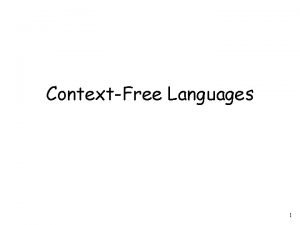Section 5 2 Defining Languages Defining Languages A
















- Slides: 16

Section 5. 2 Defining Languages

Defining Languages • A language – A set of strings of symbols – Examples: English, C++ – If a C++ program is one long string of characters, the language C++Programs is defined as C++Programs = {strings w : w is a syntactically correct C++ program} © 2005 Pearson Addison-Wesley. All rights reserved 2

Defining Languages • A language does not have to be a programming or a communication language – Example: Algebraic. Expressions = {w : w is an algebraic expression} – The grammar defines the rules forming the strings in a language • A recognition algorithm determines whether a given string is in the language – A recognition algorithm for a language is written more easily with a recursive grammar © 2005 Pearson Addison-Wesley. All rights reserved 3

The Basics of Grammars • Symbols used in grammars – x | y means x or y – x y means x followed by y – < word > means any instance of word that the definition defines © 2005 Pearson Addison-Wesley. All rights reserved 4

Example: C++ Identifiers • A C++ identifier begins with a letter and is followed by zero or more letters and digits • Language C++Ids = {w : w is a legal C++ identifier} • Grammar < identifier > = < letter > | < identifier > < digit> < letter > = a | b | … | z | A | B | …| Z | _ | $ < digit > = 0 | 1 | … | 9 © 2005 Pearson Addison-Wesley. All rights reserved 5

Example: Palindromes • A string that reads the same from left to right as it does from right to left • Language Palindromes = {w : w reads the same left to right as right to left} • Grammar < pal > = empty string | < ch > | a < pal > a | b < pal > b | …| Z < pal > Z < ch > = a | b | … | z | A | B | … | Z © 2005 Pearson Addison-Wesley. All rights reserved 6

Example: Strings of the Form An. Bn • An. Bn – The string that consists of n consecutive A’s followed by n consecutive B’s • Language L = {w : w is of the form An. Bn for some n ≥ 0} • Grammar < legal-word > = empty string | A < legal-word > B © 2005 Pearson Addison-Wesley. All rights reserved 7

Algebraic Expressions • Infix expressions – An operator appears between its operands • Example: a + b • Prefix expressions – An operator appears before its operands • Example: + a b • Postfix expressions – An operator appears after its operands • Example: a b + © 2005 Pearson Addison-Wesley. All rights reserved 8

Algebraic Expressions • To convert a fully parenthesized infix expression to a prefix form – Move each operator to the position marked by its corresponding open parenthesis – Remove the parentheses – Example • Infix expression: ( ( a + b ) * c ) • Prefix expression: * + a b c © 2005 Pearson Addison-Wesley. All rights reserved 9

Algebraic Expressions • To convert a fully parenthesized infix expression to a postfix form – Move each operator to the position marked by its corresponding closing parenthesis – Remove the parentheses – Example • Infix form: ( ( a + b ) * c ) • Postfix form: a b + c * © 2005 Pearson Addison-Wesley. All rights reserved 10

Algebraic Expressions • Prefix and postfix expressions – Never need • Precedence rules • Association rules • Parentheses – Have • Simple grammar expressions • Straightforward recognition and evaluation algorithms © 2005 Pearson Addison-Wesley. All rights reserved 11

Prefix Expressions • Grammar < prefix > = < identifier > | < operator > < prefix > < operator > = + | - | * | / < identifier > = a | b | … | z © 2005 Pearson Addison-Wesley. All rights reserved 12

Prefix Expressions • An algorithm that evaluates a prefix expression evaluate. Prefix(inout str. Exp: string): float ch = first character of expression str. Exp Delete first character from str. Exp if (ch is an identifier) return value of the identifier else if (ch is an operator named op) { operand 1 = evaluate. Prefix(str. Exp) operand 2 = evaluate. Prefix(str. Exp) return operand 1 op operand 2 } © 2005 Pearson Addison-Wesley. All rights reserved 13

Postfix Expressions • Grammar < postfix > = < identifier > | < postfix > < operator> < operator > = + | - | * | / < identifier > = a | b | … | z • The recursive case for prefix form to postfix form conversion postfix(exp)= postfix(prefix 1) + postfix(prefix 2) + <operator> © 2005 Pearson Addison-Wesley. All rights reserved 14

Postfix Expressions • A recursive algorithm that converts a prefix expression to postfix form convert(inout pre: string, out post: string) ch = first character of pre Delete first character of pre if (ch is a lowercase letter) post = post + ch else { convert(pre, post) post = post + ch } © 2005 Pearson Addison-Wesley. All rights reserved 15

Fully Parenthesized Expressions • Grammar < infix > = < identifier > | (< infix > < operator > < infix > ) < operator > = + | - | * | / < identifier > = a | b | … | z • Fully parenthesized expressions – Do not require precedence rules or rules for association – Are inconvenient for programmers © 2005 Pearson Addison-Wesley. All rights reserved 16
 Relative prononun
Relative prononun Relative clauses defining and non defining
Relative clauses defining and non defining Relative pronouns defining and non-defining
Relative pronouns defining and non-defining Defining relative clause meaning in telugu
Defining relative clause meaning in telugu Pronounlar
Pronounlar Defining and non defining relative clauses
Defining and non defining relative clauses The structure of the atom section 2 defining the atom
The structure of the atom section 2 defining the atom Half sectional view
Half sectional view Sectional view meaning
Sectional view meaning Offset section view examples
Offset section view examples Describing energy section 2 answers
Describing energy section 2 answers Study guide chapter 10 section 1 meiosis
Study guide chapter 10 section 1 meiosis Definition of smartness
Definition of smartness The defining moment in greek history is the wars.
The defining moment in greek history is the wars. Alligator phylum and symmetry
Alligator phylum and symmetry Defining social problems
Defining social problems Romeo and juliet act 4 summary
Romeo and juliet act 4 summary












